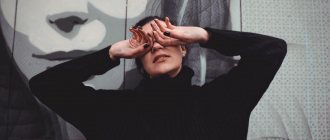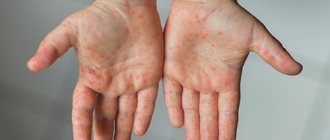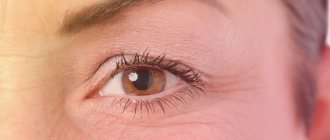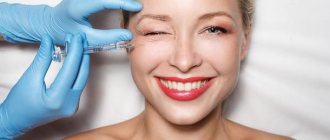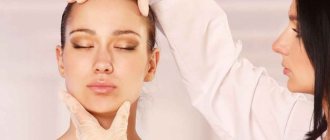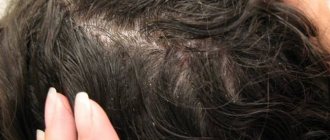Ptosis is an abnormal prolapse of an anatomical area, which in aesthetic medicine almost always occurs due to injections of botulinum toxin type A into a non-target area. Most often, this complication of botulinum therapy develops due to the inexperience of the injector. Depending on the area being corrected, after botulinum toxin injection ptosis of the eyebrows, upper and lower eyelids and lips may occur.
The drooping may persist during the period of action of botulinum toxin, but often the eyelid ptosis resolves spontaneously within 3-4 months, and eyebrow ptosis within 6 weeks after the procedure. The article estet-portal.com presents recommendations from Dr. Martin King for the prevention and treatment of ptosis after botulinum toxin injections .
- Signs, symptoms and risk factors for ptosis after botulinum toxin injection
- How to avoid ptosis after botulinum toxin injections: general recommendations
- How to avoid eyebrow ptosis after botulinum toxin injections
- How to avoid upper eyelid ptosis after botulinum toxin injections
- How to avoid lip ptosis after botulinum toxin injections
- Treatment of eyelid ptosis after botulinum therapy
- Correction of eyebrow ptosis after botulinum toxin injection
Effect of Botox on eyelids
The skin in the eye area is thin and delicate, so it is more susceptible to age-related changes than other areas of the face. In girls with active facial expressions, “crow’s feet” (facial wrinkles in the area of the outer corners of the eyes) appear at the age of 25 or earlier.
Signs of age on the face occur when blood circulation deteriorates, the structure of the dermis and muscle function change. The skin becomes less collagen, elastin, some fats, and water, which is why it loses strength and elasticity and begins to sag. And the muscles become overstrained from constant work. In the case of the eyelids, the orbicularis muscle, which is responsible for opening and closing the eyes, experiences a lot of stress.
How does this affect your appearance? Grooves and folds appear around the eyes. The upper eyelid droops (ptosis).
Combating these signs of aging is one of the most popular uses of Botox. How does it work?
Botox is a medical drug that contains the strongest poison botulinum toxin. It blocks the transmission of nerve impulses to the muscle, causing it to become paralyzed. The muscle stops contracting and stretching the dermis. The configuration of the muscular system and the vector of skin tension change. The drug is injected into the muscle through injection.
For what purposes is Botox done on the eyelids:
- smoothing out wrinkles,
- raising the upper eyelid and lowering the lower eyelid, opening the gaze,
- correction of eye opening asymmetry,
- raising eyebrows.
This article does not cover the medical uses of Botox used to treat strabismus, eye tics, and other uncontrollable muscle spasms and eye disorders.
How to avoid ptosis: prevention
Time cannot be stopped completely, but you can significantly slow down its pace by choosing an effective set of anti-aging procedures. They include many points that not only improve appearance, but also help maintain the overall tone of the body, and the famous saying says: “a woman is as old as she feels.”
Therefore, it is worth taking into account and using the entire arsenal of modern opportunities in order to feel great. The list includes:
- balanced diet;
- UV protection;
- self-massage;
- taking vitamin and mineral complexes;
- hardware cosmetology;
- good mood.
Efficiency
The effect of Botox lasts, on average, 1-5 months. Then the result disappears. Manufacturers of some drugs containing botulinum toxin claim 9 months as the maximum duration of effect, but in practice this does not happen. In some cases, Botox does not produce any results.
Remember! Botox does not solve the problem of age-related changes in the eyelids, but only creates temporary appearance. You have to pay for a fleeting illusion with health and beauty. Botox disfigures the face, is toxic to the body and - attention! – accelerates the aging process. It is a poison that only causes harm.
We prove what cosmetologists are silent about or mention in passing as something incidental and insignificant.
Causes of sagging skin
Until the age of 25-30, the body actively produces elastin, collagen and hyaluronic acid. These are the 3 main components of the frame, which maintains the tone of all layers of the epidermis. With age, their natural concentration becomes lower, which causes oval deformation and other changes. Speeds up the process:
- insufficient hydration;
- violation of the drinking regime;
- too frequent consumption of foods with a diuretic effect;
- lack of protection from sunlight and other external factors;
- binge eating;
- sudden weight loss;
- bad habits.
All these factors accelerate the loss of clear lines and provoke sagging skin. The type of gravitational aging of the face is also influenced by hereditary predisposition. Competent care using anti-aging cosmetics will help keep your skin toned and stop the development of age-related changes. In this regard, the most effective are Japanese and Korean lines, where the power of natural ingredients is combined with modern production methods.
Pros and cons of Botox for eyelids
The only advantage of Botox for the eyelids is the short-term effect of smoothed wrinkles and lifted skin, which, by the way, very often does not suit women. And such a result is definitely not worth the retribution that sooner or later will overtake everyone after botulinum toxin injections. And most often you don’t have to wait long.
So, what are the disadvantages of eyelid Botox for health, beauty and youth?
Harm to health
After Botox injections, your health often worsens: headache, injection zones. Fever, vomiting, dizziness and other health problems also occur.
It has been proven that muscles affected by botulinum toxin do not fully recover. Moreover, botulinum venom acts not only on the target muscle, but also spreads beyond the injection area. This often causes various complications to the eyes and puts the entire body at risk (details in the next chapter).
Do not forget that this is a neurotoxin, that is, it paralyzes neuromuscular activity. Just imagine that after Botox injections this poison can end up in any part of the body!
Harm to beauty
Even if you are very superficially familiar with the topic of Botox, you probably know how destructive it is for facial expressions and appearance in general. Remember the faces of the victims of botulinum therapy! Immobilized, waxy, shiny, devoid of life and attractive facial features. Faces that cannot laugh, be surprised, or frown.
It’s even worse when the emotion expressed is the opposite of the emotion experienced. Have you ever seen how a lady with a half-numb face tries to smile, and the corners of her lips treacherously stretch down, and it seems to others that she is expressing disgust? Botox!
Moreover, the Botox procedure for the eyelids is accompanied by an infinite number of side effects that disfigure the woman. And these are not exceptions, but common practice. Bruises or hematomas almost always occur because the needle damages the capillaries. The eyes often swell and new wrinkles appear. Sometimes Botox not only does not lift the upper eyelid, but provokes severe ptosis up to the complete inability to open the eyes.
Harm to youth
It’s not generally customary to talk about this, but Botox accelerates aging. This can be understood from the reviews of women who discover, a few days after the injections, new wrinkles and sagging that were not there before the procedure. And there is a scientific basis for this.
When one or more muscles are paralyzed, the muscular system is forced to rebuild its work. The muscles located next to the immobilized one begin to perform, in addition to their own, other functions that are not inherent in nature. Healthy muscle tone is disrupted and spasms occur. In areas adjacent to the treated area, the skin begins to stretch more strongly. And here they are, new age-related changes!
Harm to the body
Immediately after the administration of the poison, the patient’s well-being deteriorates. Side effects relate to pain in the injection area. Sometimes the temperature rises, dizziness and nausea appear.
Research indicates a slowdown in cell recovery after Botox injections. Botulinum venom spreads beyond the injection area. It also affects healthy areas of the skin. The effect leads to the manifestation of eye complications.
The neurotoxin affects neuromuscular activity. Once injected, the poison spreads throughout the body.
Side effects of Botox eyelids
Neurologists are wary of Botox because its long-term effects have not yet been studied.
But there are known side effects that commonly occur after Botox injections. The most common eye areas treated with poison are:
- Bruises, extensive ugly hematomas.
They arise due to damage to blood vessels during injections. - Dryness and feeling of sand in the eyes.
- Pain when touching the eyes.
- Tight skin.
- Ptosis of the upper eyelid, inability to open the eye.
The reasons for this complication are the uneven distribution of botulinum poison and its release beyond the target muscle. - Eyebrow drooping.
The reason is the same. - Severe, ugly swelling.
Due to impaired muscle tone, lymph flow suffers, which causes swelling. - Asymmetrical features.
One eyebrow may have a normal shape, while the other may droop or rise. The shape of the eyes may become distorted. And so on. - Allergy.
Up to angioedema and anaphylactic shock. - Diseases of the organs of vision.
Since botulinum toxin spreads beyond its target, it can cause complications: double vision (diplopia), - paralysis of the eye muscles,
- anisocoria of the pupils (different sizes),
- mydriasis (pupil dilation),
- strabismus,
- blindness.
And if after the first Botox injection such consequences already occur, imagine what will happen next! After all, it won’t be limited to one visit to a cosmetologist. In a month or two, the wrinkles will return and new signs of aging will appear. The procedure is allowed to be done once every three months. Just imagine: poisoning yourself every season!
But the body will begin to get used to botulinum toxin, its effect will begin to weaken. You will have to go to the cosmetologist for a new portion of poison almost as often as for a manicure. And the doses will increase. Physical and psychological dependence will become so strong that it will be almost impossible to get off the needle. The face will acquire ugly features, and Botox correction will not correct anything.
Complications
The disease is not life-threatening. In most cases, the consequences are psychological in nature, provoking the emergence of complexes, the development of shyness, internal constriction from the awareness of a defect in appearance. A narrowing of the visual field and headaches also begin.
It is more difficult for children; progression of amblyopia and other disorders, including binocular vision, is possible. The outlines of objects are distorted, which causes partial disorientation in space. In severe forms, there is a high probability of developing a myasthenic crisis.
If the causes of facial ptosis and drooping upper eyelid are found, the doctor will tell you what to do, how to fight and remove the main symptoms. This will not be difficult, since the actions will be targeted, and the methods will be clearly selected and comprehensive.
What drugs are used for Botox?
Initially, Botox was the name of the first drug containing botulinum toxin, although now this is the name of the entire category of drugs containing this poison. The Botox brand was released about 30 years ago by Allergan from the USA.
Following this, competing brands began to emerge in different countries. The main competitor of Botox is Dysport, produced in France. The most expensive drug is the German Xeomin. A cheap Chinese analogue of Botox is Lantox. The most active country in the “youth injections” market is South Korea, which has released Botulax (almost exactly the same as Botox), Neuronox, Meditoxin, and Heutox. This trend was not lost on Russia either, which presented its Relatox about six years ago.
All drugs have the same active ingredient - botulinum toxin type A (BTA), once developed as a bacteriological weapon. The products differ in production technology, dosage, particle size, composition of excipients, strength and duration of action, sensations during and after the procedure, and so on.
What nuances in the compositions do you need to know about?
First, molecular weight matters. The smaller the particle size, the more evenly the drug is distributed throughout the muscle, but at the same time it more actively goes beyond the target, that is, it creates the threat of complications. Botox has a large molecular weight (relative to some other drugs). Dysport has almost two times lower. The smallest is that of the German Xeomin and the Russian Relatox (six times lower than Botox).
Secondly, it is worth paying attention to the presence of stabilizers in the composition that inhibit the botulinum toxin molecule. With them, it acts more softly and does not spread so actively beyond the target target. In Botox it is albumin (human immunoglobulin) and sodium chloride. Albumin is also found in Dysport (in smaller quantities), Xeomin (in larger quantities), and Botulax. Relatox doesn't have it. Instead of albumin, Lantox contains gelatin of animal origin
Thirdly, the quality and degree of purification of BTA matters. It is believed that Xeomin has the highest price, which is why it is more expensive.
The concentration of BTA in the drugs is also different, which affects the dosage. If you need 10-20 units of Botox for crow's feet, then 30-60 units of Dysport.
Botox has average strength and duration of action. Dysport is more powerful. Xeomin is softer. Relatox begins to act faster and the effect lasts longer.
Description of the procedure
The Botox procedure for the area around the eyes takes 20-30 minutes.
First, the cosmetologist marks the injection sites with a marker. To identify problem areas, the patient smiles, frowns, and so on.
As a rule, injections are given at four points near each eye: two near the outer corner of the eyes and one near the tip of the eyebrow and in the area of the bone border.
After the injections, wait 10 minutes.
Typically, the effect appears on days 3-7 and reaches its maximum after two weeks.
Cost of eyelid botox procedure
To treat crow's feet with Botox, it takes 10-15 units of the drug on one side. About 5 more units are needed to raise the eyebrow and then the eyelid. In total, Botox for two zones (near the left and right eyes) requires 30-40 units per procedure.
This will cost, on average, 2 thousand rubles. But this is the price only for the drug. Another additional 500-2000 rubles for a consultation with a cosmetologist.
Often, after the first procedure, correction is required two weeks later, and this is additional poison and expense. As you get used to the drug and signs of age increase, the dosage increases.
Administration of another dose of botulinum toxin
If after Botox the upper eyelids droop, then the cosmetologist may decide to inject another dose of the drug into the fibers that lower the upper problematic eyelid. This method will help balance the strength of the muscles, after which the eye will open normally.
There is another option that can be used for mild ptosis. The cosmetologist finishes off the muscles that raise the eyebrow on the opposite side. After this procedure, it will lower slightly, the size of the eyes will become almost the same and the asymmetry will be barely noticeable.
Opinion of cosmetologists
The official position of cosmetologists is on the side of Botox, since it is a commercially profitable procedure. They do not talk about muscle paralysis and forced restructuring of the muscular system, but call this process the harmless word “relaxation.” And Botox in their language is not a neurotoxin, but a muscle relaxant. The aggressive image of the deadly botulinum toxin is smoothed over by the thesis that it is used in micro and nano doses.
But in confidential conversations, cosmetologists say completely different things. Many of them do not inject themselves with Botox, and this is not without reason. Read professional forums where cosmetologists communicate with each other. There is a lot of useful information about how botulinum poison acts on the body, how patients get hooked on the needle, and what the consequences are.
Many are sounding the alarm that there are very few experienced cosmetologists in the industry. Dosages, administration techniques, and storage periods are often violated. The drug is diluted incorrectly and the injection site is missed. Low-quality, expired materials, etc. are used.
You can also talk to neurosurgeons. Many faces, distorted after Botox, pass through their hands.
Patient reviews
Those who have had Botox done to the eye area write that:
- no effect
- a frozen surprised look appears,
- injection sites become numb,
- eyelids become very swollen for several months,
- the eyes stop opening completely or partially,
- the face swells, the skin collapses when touched,
- the upper eyelid droops,
- new wrinkles appear.
Quote from a patient who had Botox done in the eye area:
“I can’t open my eyes and I have no idea when this horror will return to normal.”
The review was updated 7 months after the procedure:
“The drooping eye remained unchanged. After consultation with a neurologist, neuropathologist, after a total examination by an ophthalmologist, an MRI of the brain and facial nerve, and an appointment with a leading neurosurgeon, the unequivocal verdict is Botox’s FAULT!”
Diagnostics
It is worth considering that the most effective measures can be taken in the early stages of diseases. Unfortunately, at this stage it is very difficult to notice changes. You should be wary:
- visual enlargement of the skin fold;
- eyelid asymmetry;
- narrowing of the field of view;
- rapid fatigue of facial muscles;
- the desire to tilt your head back to examine a small detail in detail;
- the appearance of longitudinal wrinkles on the forehead.
If you suspect the development of pathology, you should contact a specialist to clarify the diagnosis. First of all, it is determined whether the anomaly is congenital or acquired. Next, an examination is carried out to determine the degree of prolapse. In case of vision problems, it is necessary to evaluate how much the field has narrowed, measure the eye pressure and examine the condition of the fundus. The next step is to check muscle tone and blinking function, and the quality of binocular vision.
Among the examinations that are prescribed:
- X-ray;
- MRI;
- Ultrasound;
- electromyography.
In some cases, with an unclear etiology, consultation with a neurosurgeon, endocrinologist, or neurologist may be necessary. The disease develops gradually.
1st degree
The upper eyelid hangs over the cornea or covers a third of the pupil. At this stage, there are quite a few options for how to treat eye ptosis. Basically, they are of a conservative direction, since there is no serious threat to visual acuity, the main concern is the cosmetic effect.
2nd degree
At this stage, half to two-thirds of the pupil closes, pain, headache, and overstrain of the muscles of the face and neck appear. Visually, the violation is clearly visible and causes not only psychological, but also physiological discomfort.
3rd degree
At this stage the pupil is completely closed. Surgery and long-term rehabilitation, including several stages, are required. The first step is to identify the causes, both the main ones and the accompanying ones. Only then can treatment be prescribed, constantly monitoring the patient’s well-being and the process of restoration of visual functions.
We recommend
GHC Placental Cosmetic - 3-D modeling mask with placenta hydrolyzate
Bb Laboratories – Regenerating placental-hyaluronic mask
Bb Laboratories – Anti-aging lifting cream
Bb Laboratories – Lifting patches
Swelling of the eyelids after Botox
After Botox, the eyelids often swell to the point of being ugly. Swelling can last for several days or weeks, or it can become a chronic problem.
Quote from a patient who had Botox on her eyelids:
“Every morning for 3 months now I have been getting up with swollen eyelids, although in a normal, Botox-free life I am not prone to them from the word “at all.”
Drug treatment
Modern methods of correcting the situation when eyelids droop after Botox include the use of medications that will help speed up the restoration of mobility of problem muscles and strengthen nearby fibers.
For these purposes the following are often prescribed:
- vitamin complex for oral administration “Neuromidin”;
- injections of "Proserin";
- Apraclonidine eye drops;
- mesotherapy cocktails with active substances that accelerate the restoration of muscle tone and mobility.
Course use of Apraclonidine allows you to raise the edge of the eyelid by approximately 1-2 mm. This is sufficient for mild to moderate ptosis, but for severe ptosis this method is only suitable as part of complex therapy.
Eyelids drooping after Botox: what to do
First, let us remind you that one of the stated goals of Botox is to lift the eyelids. This alone is doubtful. Many talk about the ineffectiveness of the fight against ptosis with Botox and confirm this with photographs taken 2-3 weeks after the procedure. They show that the eyelids did not rise at all, but continued to hang over the eye, as before.
Moreover, after Botox injections, the problem of the impending eyelid may intensify or appear if it did not exist before. This complication is especially often accompanied by forehead Botox. What's happening? The frontalis muscle becomes immobilized under the influence of botulinum poison, and stops contracting and holding what it previously held. The eyebrows fall over the eyes and pull the eyelids down.
To get rid of swelling, drooping eyelids and other complications after Botox, you need to speed up the removal of the toxin from the body. To do this, we recommend doing everything that improves blood circulation and lymph flow and speeds up metabolism. These are physical exercises, self-massage of the face (can be done no earlier than two weeks later, otherwise the effect of the poison will increase), exposure to high temperatures (baths, saunas). The body also needs a lot of water.
Symptoms
In order not to confuse ptosis after injections with other pathologies, you need to know about the symptoms. The eyelid may droop either on the third day or after a few weeks. This is very noticeable. Obvious asymmetry gives the face an unpleasant, tired expression and the gaze a heaviness. In this case, blinking is impaired, as a result the eyeball is almost deprived of hydration and cleansing, as well as:
- your eyes begin to hurt;
- blood circulation is impaired;
- headaches, strabismus and lacrimation appear.
By location, swelling is most often unilateral, but it can also be bilateral. Thus, a situation may arise when, for one reason or another, the eyelids droop after Botox. What to do? Photos and reviews of other patients, the opinions of doctors - all this is of interest, but the main thing is not to panic.
How to get rid of wrinkles and lift eyelids without Botox
The surest way to transform the eye area is a properly selected set of exercises. MelAnnett has been developing a program for natural rejuvenation of the body for several years and testing it in practice. As a result, the “Basic Marathon” was created. This is a set of exercises that straightens the back, relieves muscle tension, improves blood supply and lymphatic drainage, that is, it solves the main problems that provoke age-related changes. At the end of the marathon, each wrinkle is polished separately.
Among other results, MelAnnett's Basic Marathon helps eliminate crow's feet and lift eyelids.
If you've already had Botox and are unhappy with the effect, don't let yourself down! Get started on your recovery by taking part in the Basic Marathon!

